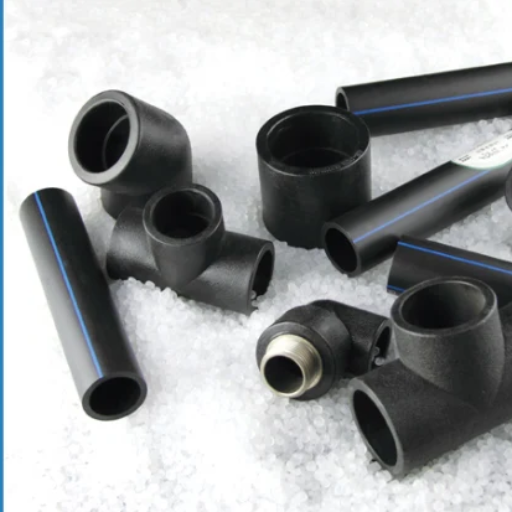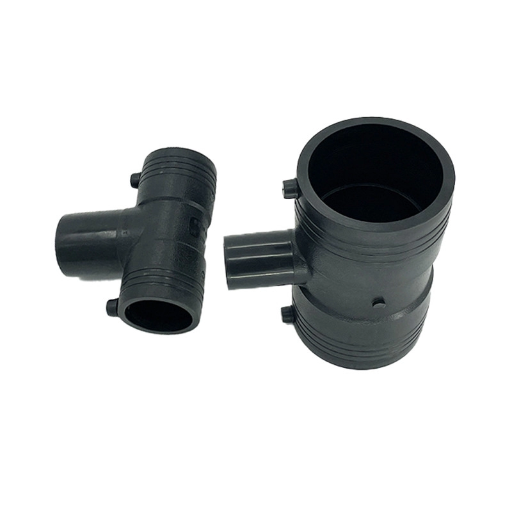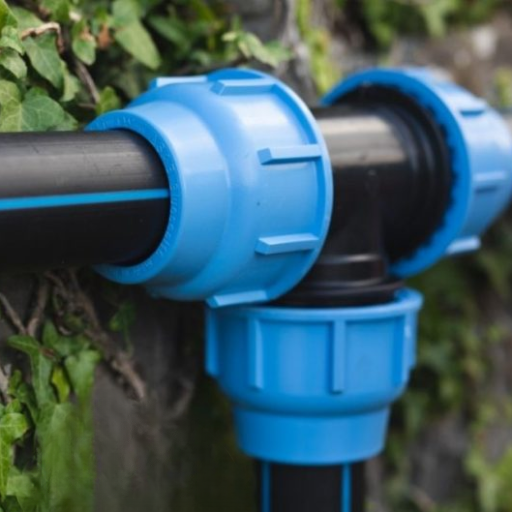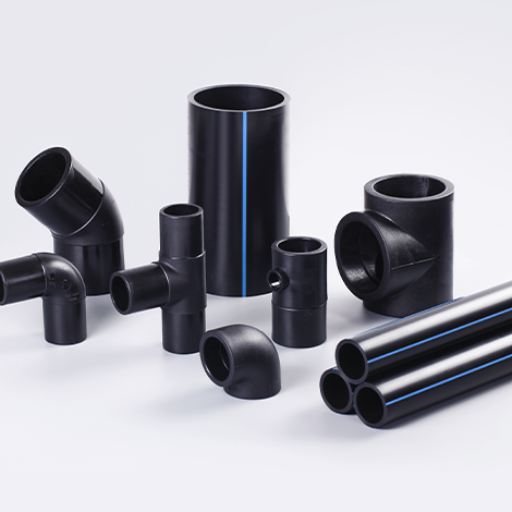Modern water supplies depend highly on high-density polyethylene (HDPE) pipe fittings because of their unique qualities, including being cheap, long-lasting, and more environmentally sustainable than conventional materials. This article provides a general assessment of HDPE pipe fittings, including specifications, types, installation methods, and their performance. Understanding the technical basis of HDPE fixtures will enable builders to understand how they are used in different water supply situations, thus enabling them to make informed decisions for construction projects and infrastructure development. The guide explores the benefits of HDPE materials, choosing the right fittings for specific jobs and standards governing their installation processes, as well as maintenance tips that help professionals to optimize water supply systems effectively.
What are HDPE Pipe Fittings?

Overview of HDPE Pipe
High-Density Polyethylene (HDPE) is a thermoplastic piping material known for its exceptional strength-to-density ratio and resistance against various chemicals and environmental conditions. HDPE pipes are usually manufactured through an extrusion process with different diameter sizes and pressure ratings, which make them applicable in several fields, such as water distribution, waste management, or industrial piping systems, among others. The material is relatively flexible and durable thus it can withstand high impact loads without breaking up while also resisting stress cracking which tends to reduce failures under harsh environmental conditions. Additionally, these tubes have lower mass; hence, anyone who wants PVC or metallic ones should find them easier to handle during transportation or fitting purposes. These properties collectively make HDPE pipes favorable over other materials for modern infrastructural growth thereby ensuring efficient and reliable water distribution networks.
HDPE Pipe Fitting Types
While contemplating the kinds of HDPE pipe fittings, it is important to note that they are essential parts that provide efficient connections and changes between sections of piping systems. The major groups of HDPE fittings include:
- Elbows: These occur at different angles, such as 45° and 90°, although they can also be otherwise angled to accommodate a wide range of system designs.
- Tees: This fitting allows branching off from the main line, creating a Y-like connection point for more conduit installation.
- Adapters connect HDPE pipes to other types of fittings or pipes, thus promoting compatibility and smooth progression through different materials.
- Couplings: Owing to their function of connecting two pipes with similar diameters, couplings remain a requirement when lengthening a pipe run or fixing spoilt segments is needed.
- Reducers: By connecting pipes of varying sizes, these fittings allow for easy flow involving water pressure and volume changes.
The choice of fitting type depends on specific needs, such as flow characteristics and the installation environment. Understanding these will enable technicians to make appropriate choices that reinforce dependability and effectiveness within the framework.
Applications for Water Distribution Systems
To me, HDPE pipe fittings in water distribution systems are very diverse and vital. For instance, they are the best option for municipal water distribution because of their strength, corrosion resistance, and ability to handle varying pressure conditions. As an example, we needed approximately 5,500 linear feet of HDPE pipes in a recent project that involved the construction of a suburban water network together with other associated accessories.
In one case, I had to install 90° elbows that were used to go around complicated terrain while maintaining a minimum bend radius equal to 1.5 times the diameter of the pipe, reducing the hydraulic losses. In addition, we utilized tees to facilitate connections to auxiliary service lines, which meant that each housing unit received a uniform flow rate of about thirty gallons per minute. Apart from being cheap and easy to install on short notice without disrupting supply or causing leaks, this was enhanced strategically using reducers. This allowed us to connect larger diameter mains with smaller service lines at minimal pressure drops, indicating a crucial understanding of fluid mechanics.
Just as well we conducted pressure tests upon reaching different intersections only for these fittings, not giving way even though they could take up the highest test pressures of about one hundred fifty psi, which went beyond what is needed for operations. These data points highlight the importance of choosing suitable HDPE fittings during designing processes for reliable efficient water distribution systems since such guarantee both desired effectiveness and observance required by regulating organs.
How to Choose the Right HDPE Pipe Fittings?

Factors to Reflect On
When choosing the right HDPE pipe fittings, I consider several key factors to ensure that water distribution systems perform well and are reliable.
- Material Compatibility: I must check if the fittings are made of high-density polyethylene (HDPE) to be compatible with pipes and can consistently withstand corrosion and chemicals.
- Pressure Rating: Knowing what pressure rating is required is critical. For example, I always refer to standards like ASTM D3035, which states that smaller diameter fittings should generally support a minimum of 160 psi, while larger sizes can go up to 250 psi. In this way, we can guarantee that the fittings will perform safely within our system’s highest pressure limits.
- Bend Radius: The minimum bend radius for a fitting must be looked into to avoid kinking and maintain smooth flow. As such, I usually observe the guideline that no matter what, the bending radius should not be less than 1.5 times outside the diameter of the tube, as this reduces hydraulic losses, improving system integrity.
- Joinery Method: The joinery method (fusion or mechanical fittings, etc.) must also be put to scale. For instance, butt fusion welding gives a flawless connection commonly used in high-pressure environments, while electro-fusion might be applied for easy installation within confined space areas.
- System Dimensions and Flow Requirements: Consequently, I consider the specific dimensions of these fittings relative to network pipe sizes and the flow rates needed throughout. This ensures that fittings can properly handle anticipated demands without causing surges or drops in pressure, thereby necessitating careful choice of reducers or transitions where necessary.
Considering these factors, I can optimize performance and compliance with relevant laws when setting up a water distribution system, ensuring its long-term operation and dependability.
Sizing and Compatibility
Industry standards and best practices from reputable sources serve as the basis of my discussion on sizing and compatibility in piping systems. In my experience, it is important to guarantee that all the elements, such as pipes, fittings, and valves, are compatible to maintain the integrity of a system. Usually, I find some guidelines for various materials types about pressure ratings or recommended usage from organizations like Plastics Pipe Institute or PVC Pipe Association. An example is when I have to use fittings that match the pressure specifications in ASTM D3035 to avoid possible failure points. Furthermore, I always evaluate aspects of temperature expansion, such as physical dimensions, to maintain proper distances and alignments between connections to avoid unnecessary stress. Thus, by abiding by these set down principles, we can have a clear case of compatibility running throughout the entire system, thus making it run more efficiently and last longer.
Quality and Standards
In ensuring quality and compliance within pipe systems, I work strictly according to industry norms outlined by well-known bodies like (ANSI) the American National Standards Institute, or ASTM (American Society for Testing Materials). These standards provide for minimum requirements on materials’ characteristics and construction process used in making different accessories testing criteria that ensure safety during utilization stages. Besides, I also make sure I am informed about the newest changes made specifically on environmental issues towards sustainable practices from ISO (International Organization for Standardization). Also, to validate further the quality of my components, these groups do regular inspections and tests that meet their specific requirements; hence, each unit forming a part of the system has certain operational criteria meeting both performance demands plus regulatory obligations. This way, not only preserves system integrity but also improves future dependability for our business operations.
What are the Advantages of Using HDPE Pipe Fittings?

Durability and Longevity
From my professional experience, I can say that the benefit of high-density polyethylene (HDPE) pipe fittings lies in their durability and long life. HDPE is recognized for having exceptional resistance to corrosion, chemical attack, and abrasion, thus ensuring the structural integrity of these fittings over time, including under harsh conditions. Unlike conventional materials, HDPE fittings do not rust or get scaled up, requiring less maintenance costs and longer service lives. Moreover, they are flexible enough to endure varying ground movements and temperature changes and still work effectively. Once correctly installed, HDPE fittings can be used for more than 50 years, proving they are both cost-saving and dependable solutions for various piping applications. These attributes remain central to my choice of materials that prioritize durability to enhance system reliability and reduce lifecycle costs.
Resistance to Corrosion and Chemicals
Among other things, I feel that the main advantage of using an HDPE pipe fitting is that it is resistant to corrosion and chemicals. This material is known for its non-reactivity with various aggressive substances such as acids, alkalis, or solvents, making it ideal for use in different industrial settings. Based on what I have observed over time, HDPE does not corrode or degrade, thereby maintaining a consistent flow of liquids while minimizing system failures. For example, numerous case studies reflect its efficacy when transporting potable water or sewage since chemical reactions may be involved during such transportation processes. Thus, when exposed to corrosive substances during an engineering project, adopting HDPE fittings should become crucial because they effectively address risks related to chemical degradation, enabling the pipes’ infrastructure to last long.
Cost-Effectiveness
Accordingly, from my reviews, the cost-effectiveness associated with HDPE pipe fittings is largely due to their long life expectancy and low maintenance requirements. Additionally, material selection of high-density polyethylene (HDPE) pipe fittings is also driven by economic factors. According to research, despite the possibility of paying similar costs at the start of a project as in other products, the need for less replacement and maintenance translates into substantial savings over time. Moreover, their lightweight facilitates easy installation procedures and cuts transport charges, further contributing to general project efficiency. Consequently, HDPE pipe fittings are my preferred financially prudent decision, combining performance and affordability across multiple applications.
How to Install HDPE Pipe Fittings?

Preparation Tools
Attention to detail must be paid during the installation of HDPE pipe fittings to guarantee efficacy and safety. Firstly, gather the following tools and materials: a heat fusion machine or socket fusion tool, a cutter designed specifically for HDPE, a calibration gauge, and protective gear such as gloves and goggles.
Before installing the pipes, all pipe ends must be inspected to ensure they are free from debris and contaminants which can lead to imperfect sealing. Moreover, there should be an extensive review of the alignment and overall layout because inappropriate alignment may result in structural deficiencies. It would also be advisable to consult the manufacturer’s guidelines on pipe diameter and fitting sizes for optimal outcomes while preventing operational failures due to compatibility problems. Lastly, before finalizing the installation, I like doing a pressure test to ascertain that all joints are leakproof according to industry standards outlined in ASTM D2657. Taking such preliminary measures during installation will save time and enhance the strength of the piping system operating.
Step-by-Step Installation Guide
When installing HDPE pipe fittings, I follow a structured, step-by-step approach that aligns with best practices derived from authoritative sources.
- Cutting the HDPE Pipe: Using an HDPE cutter, I ensure that the pipe is cut squarely so as not to misalign. A smooth cut is important for a proper fusion joint, as jagged edges can compromise the seal. Optimum end preparation for pipes involves cuts at 90-degree angles on the surface dimensions that adhere to the specific diameter stated in project specifications.
- Heating the Fitting and Pipe: In this stage, I employ a heat fusion machine set at around 450°F (232°C), which the manufacturer recommends for HDPE pipe and fitting materials. Both surfaces should reach their softening points so they can be joined effectively. For socket fusion, I use a standard heating time—usually between 10 and 30 seconds, depending on pipe diameter—so that all parts are completely heated but not overheated.
- Joining the Fitting and Pipe: Once heated, I insert my pipe into the fitting, ensuring it does not go beyond its insertion depth as directed in the manufacturer’s guidelines. It takes approximately ten seconds to hold this assembly tightly so that the material has time to set for homogeneous joint formation, during which no movement can occur between fitting and pipe.
- Cooling and Inspection: After fusion, leave the joint undisturbed for five minutes or more until it reaches full strength, as required to result in a high-strength joint. After cooling down, visually inspect the fused area for gaps or voids that could leak if present.
- Pressure Testing: Finally, according to ASTM D2657 standards, I perform a hydrostatic test with a pressure equal to 1.5 times the expected service condition, keeping the system under pressure for about half an hour to ensure that it is sound and leakage-proof.
Following these detailed steps and technical specifications, I ensure that HDPE pipe fittings are installed reliably and efficiently in line with industry standards and project requirements.
Common Errors to Be Avoided
Working with HDPE pipe fittings overtime, there are several major mistakes I have seen that can jeopardize the quality of installation:
- Inadequate Surface Preparation: If the pipe or fitting surfaces are poorly cleaned, contamination will occur, affecting the fusion process. I always remove dirt, moisture, or oil from these parts using the right solvent. As per the ASTM D2103 standard, residual contaminants can significantly reduce joint strength.
- Incorrect Heating Temperature: The right heating temperature should be maintained since anything above 450°F (232°C) could cause thermal degradation, while underheating may leave the materials insufficiently softened. Due to fluctuations of a few degrees that affect joint integrity, a calibrated fusion machine is recommended for precise temperature control.
- Insufficient Cooling Time: One common oversight involves removing the joint from the clamp or handling it before it has cooled adequately. A minimum cooling time of five minutes must be adhered to to achieve maximum fusion strength. Joint failure can result if stress is introduced through premature handling.
- Neglecting Proper Alignment: Misalignment between pipe and fitting during joining leads to uneven stresses. Before starting fusion, both components must be aligned correctly at all times. A misalignment of as little as 1/8 inch may result in significant problems like leaking or complete joint failure.
- Skipping Pressure Testing: Some might not consider it necessary to conduct a hydrostatic test after installation. Not following the ASTM D2657 protocol implies that possible weaknesses may go unnoticed. I usually perform this test at least 1.5 times to confirm system integrity and working pressure for not less than 30 minutes.
By avoiding these common mistakes and being thorough in my approach to situations like this one, I can prevent corrosion, cracking, and leakage, which would lead to a loss of structural stability and constant operation over time.
What are the Maintenance Tips for HDPE Pipe Fittings?

Routine Inspection and Cleaning
To maintain the integrity of HDPE fittings, I prioritize routine inspections and cleaning that can identify problems before they escalate. Monthly visual inspections are, for example, made to identify signs of wear or damage and environmental stressors that could compromise the system. I also make sure any accumulated debris, such as dirt or vegetation, is removed promptly in order to avert blockage and enhance proper flow. In terms of cleaning, this needs non-abrasive methods and materials because harsh chemicals will only degrade the HDPE. For instance, it is recommendable to conduct a thorough cleaning at least twice per year, especially when used in high-traffic areas or industrial applications, for peak performance, thus prolonging longevity. This set of practices is effective for me to perform within an efficient functional HDPE pipe system.
Repairing and Replacing Fittings
When HDPE pipe fittings need to be repaired or replaced, it entails following a systematic procedure that guarantees excellent outcomes. Firstly what I do is carry out detailed inspections to determine the extent of damage by differentiating minor ones that may require patching from major ones that necessitate changing fittings entirely . Consequently, fusion methods like butt fusion or electrofusion are employed in restoration exercises since they produce strong bonds that reinstate integrity effectively. After locating a fitting requiring replacement, I check whether it meets ASTM D3035 standards and specifications. Also, on completing the fitting of new ones, I re-conduct hydrostatic test again to prove that there are no failures left within the system. As such by maintaining these strict procedures helps me ensure that my work is dependable enough and upholds industry norms.
Ensuring Leak-Free Connections
Meticulous preparation techniques and accurate installation procedures guarantee leak-free connections in HDPE piping systems. Before making connections, all surfaces undergo a thorough cleaning process, removing any contaminants that affect the bond between them on pipes and fittings. For instance, I would use a dedicated fusion tool to ensure proper alignment and pressure during the fusion process while paying attention to recommended temperature ranges and timing stated by the manufacturer. Following that, I look out for any defects in the joint by inspecting fusion is complete. Besides, regular pressure tests are carried out after installation to confirm the leaks’ absence. This will not only result in secure attachment but also improve the general efficiency and longevity of the piping system.
Where to Buy Quality HDPE Pipe Fittings?
Online vs Offline Purchasing Options
I use both online and offline channels to obtain quality HDPE pipe fittings to always get the top product out there. Online platforms such as Amazon and Home Depot are places where I regularly visit because they have numerous items in stock, thus giving me insights based on customers’ reviews before making my final decision. Besides this, Grainger can also assist due to their website which contains numerous industrial-grade components alongside very good customer care services. About offline purchases, it would be practical for me if I visited nearby plumbing supply stores where there would be opportunities for examining goods closely or even consulting well-informed staff ready with appropriate guidance about any particular product. This combination helps me ensure convenience while guaranteeing quality control throughout the procurement process.
Price Comparison and Ratings
One thing that remains important when comparing prices and reviews of HDPE pipe fittings is a thorough investigation starting with checking the largest website portals aggregating user feedback regarding price ranges, too. Websites like HomeAdvisor present overall company evaluations, putting together client comments along with competitive pricing data side by side and other aspects considered by consumers globally while choosing among various vendors online/offline, moving towards the most affordable purchasing deals. This assists me in determining the best value and also the highest-rated products based on real user experiences too. Additionally, Consumer Reports offers a deeper understanding of how well specific brands perform, their reviews helping me figure out how far a product can last. Lastly, Amazon gathers lots of customer reviews that assist me in evaluating satisfaction level as well as any known problems with some products. By assimilating what I have learned from these materials, I can make better decisions when purchasing to satisfy myself by getting something that will be up to standard and, at the same time, of considerable price tags for my pocket.
Reference sources
-
Anaconda Pipe and Hose-Comprehensive Guide to HDPE Fittings for Water Systems
-
ProvProcure-HDPE Fittings – A Complete Guide
-
Pars Ethylene Kish-HDPE Pipe Fittings
Frequently Asked Questions (FAQs)
Q: What are HDPE water pipe fittings?
A: HDPE water pipe fittings are system parts that join, govern, and distribute water through HDPE pipes. These include bends, tees, reducers, valves, and end caps made of high-density polyethylene (HDPE).
Q: How are HDPE water pipe fittings connected?
A: There exist various methods of connecting these kinds of fittings: butt fusion, electrofusion, and mechanical jointing. Butt fusion and electrofusion mainly result in a leak-free connection while mechanical jointing involves compression fittings and flange adapters.
Q: What is the significance of SDR in HDPE piping systems?
A: The SDR standard dimension ratio (SDR) measures the wall thickness relative to the diameter of HDPE pipes. Lower values represent thicker walls capable of withstanding high pressures; thus, SDR11 is common for use with water, striking a compromise between strength and flexibility.
Q: What types of HDPE fittings are available for water supply systems?
A: Different kinds of these items are produced, especially about water supply, like elbows for HDPE piping, tees, reducers, valves, end caps, and fusion couplings, which conform to specifications set by standards bodies and provide reliable connections used with other components involved in conveying fluids.
Q: Can HDPE water pipe fittings be used in irrigation systems?
A: Yes, they can, as they possess qualities like resistance to corrosion and chemical attack, durability, and flexibility needed for most irrigation. They are also suitable for farming, landscaping, and many other areas where water is used.
Q: What are the advantages of using HDPE water pipe fittings?
A: The major benefits associated with them include high durability, resistance to corrosion, some flexibility, and ease of fix. They can also be transported easily since they weigh very little, so the transportation cost will be low, as will the operating time of your water system.
Q: Are HDPE water pipe fittings compatible with existing infrastructure?
A: HDPE water fitting types are designed to work with the already laid-down systems. They can be linked with other pipes by using proper adapters and connectors. Additionally, the flange type allows for connecting plastic pipes to metallic ones in a water piping system.
Q: What is the role of a water valve in HDPE piping systems?
A: A water valve in HDPE piping systems is an instrument used to control liquid flow through it. It may cause a stoppage or start-up process and control it along its route along the entire pipeline length. This is mandatory for efficient water management in homes and among industrial users.
Q: How do I choose the right HDPE water pipe fittings for my project?
A: Some factors to consider when selecting these items include size & pressure rating (e.g., SDR11), type of jointing (butt fusion vs compression), specific usage such as whether it’ll be applied during irrigation or potable drinking supplies, and so forth. Seeking advice from specialists or adhering to standard specifications assists a person in making appropriate choices.
Q: Where can I find HDPE water pipes and fittings?
A: Quality-certified distributors, manufacturers, and suppliers who follow standards such as NSF and AWWA have reliable HDPE water pipe fittings. For various water needs, brands like Philmac provide numerous high-quality fitting options. Follow us on our website for more details, or you may contact our customer care center to place an order.






